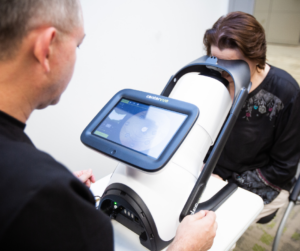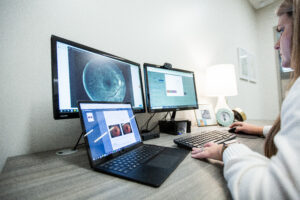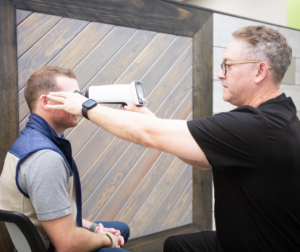Louis Morrow, VP of Sales, Reveals How Using IRIS Leads to Improved Patient Outcomes

In healthcare, improving patient outcomes is priority number one.
However, to improve patient outcomes, healthcare professionals and providers must implement new technology that makes treatment more accessible to more patients.

Unfortunately, that’s more difficult than it sounds—especially for patients with diabetes who have limited access to the care that they need. From time constraints and transportation to affordability and lack of urgency, there are many barriers to treatment that prevent healthcare providers from improving outcomes for diabetic patients. Without proper treatment, severe consequences can occur, especially with the threat of diabetic retinopathy.
Here’s Louis Morrow, VP of Sales at IRIS:
“Diabetic retinopathy is the leading cause of blindness in the U.S. today, not only amongst diabetics but amongst the general U.S. population. Yet, less than half of diabetics actually go to their eye care provider for an annual eye exam.”

Louis Morrow
To increase the detection of diabetic retinopathy, eliminate preventable blindness globally, and improve patient outcomes, healthcare providers must integrate solutions like IRIS into their systems.
In this blog, we’ll walk you through how using the IRIS solution can lead to improved patient outcomes. Plus, IRIS VP of Sales, Louis Morrow, gives his insights into how an improved patient experience can benefit population health on a global scale.
How IRIS Improves Patient Outcomes
Focusing On Preventative Care
As said earlier, less than half of people with diabetes receive an annual test to aid in detecting sight-threatening pathogens. However, Morrow says,
“If we can help our health system partners diagnose this disease state sooner, ultimately we can help in the process of preventing vision loss.”
By focusing efforts on preventative care rather than treating patients when their sight is already in jeopardy, improved patient outcomes can be achieved. To properly implement preventative care, the barriers to treatment that make detection and diagnosis impossible must be broken.
That’s why the IRIS solution meets patients where they are.

Meeting Patients Where They Are
The primary advantage of IRIS’s proprietary software is that it meets patients where they are. Whether that’s their home, a retail space, or their primary care practice, the IRIS solution integrates with portable fundus cameras to make diabetic retinopathy detection more accessible.

However, with the recent shift to telehealth and telemedicine, many patients have found it much easier to participate in virtual care.
“There was some data that was published in the Journal of American Medical Association during the pandemic which stated that there was a 21% reduction in primary care visits. And we can certainly understand why.”
Unfortunately, retinal imaging technology is not at the point yet where it can be done virtually. So, the shift from in-person visits to virtual has been somewhat detrimental to the detection of diabetic retinopathy and other sight-threatening pathogens.
That’s why IRIS is integral to ensuring improved patient outcomes. It removes the barriers to treatment that traditionally prevent patients from receiving better care and fits more seamlessly into patient preferences for receiving treatment that is convenient.
Enhancing Retinal Images and Detecting Sight-Threatening Pathologies
The IRIS solution is also able to improve patient outcomes by enhancing retinal images once the image is taken and sent to the IRIS platform.
“Historically, our success rate (number of images or exams able to be interpreted remotely) is 93-94%.”
With this level of success, over 1 million screenings administered, and more than 130,000 IRIS saves, there is about a 30% incidence of pathology found when applied to the overall diabetic population.
However, it is not only diabetic retinopathy. The IRIS solution is also cleared to diagnose macular edema. Plus, there are a host of other suspected conditions that our licensed physicians in the IRIS Reading Center are able to notate and add to a patient’s final report. These include eye-threatening diseases that can affect the entire diabetic population such as glaucoma, cataracts, macular degeneration, and hypertensive retinopathy.
Whether or not any of these sight-threatening conditions are detected, the results are sent to the existing client’s EHR or EMR with recommended next steps and a care plan associated with the diagnosis or detection.
Acting as Ongoing Partners
For some patients, it can be difficult to receive access to a diabetic eye exam even though the actual exam is simple.
“This diabetic eye exam is almost universally the most challenging care gap for those value-based care partners to satisfy.”
Because of the challenges, IRIS is not built to just be a software supplier. We create partnerships with the clients we serve to satisfy HEDIS requirements and improve patient outcomes.
“We see it as just that, a partnership and not a transaction. We’ve talked to healthcare providers who’ve thought ‘All we need to do is simply buy some cameras and problem solved.’ Unfortunately, they then call us and say they still can’t figure it out, so we have to step in and coach them through the process.
It takes more than just a camera to do this successfully. Cameras are important, and thankfully, the technology is advanced to where you can do this with an easy-to-use portable piece of hardware. But there’s more to it than that, and we’re happy to help.”
Achieving Improved Patient Outcomes With IRIS
Diabetic retinopathy is the leading cause of blindness in adults. To improve patient outcomes, healthcare providers need to start by administering more preventative screenings that break through the traditional barriers to treatment that impact many diabetic people. All of that starts with IRIS.
The IRIS solution leads to improved patient experiences. By meeting patients where they are and providing proprietary software that improves the readability of retinal images, there is a higher likelihood of detecting diabetic retinopathy sooner in more patients, improving patient outcomes.
To get started, contact IRIS. Together, we can end preventable blindness for improved patient outcomes across the country.
Frequently Asked Questions
Why Is It Important to Improve Patient Outcomes?
Improving patient outcomes is paramount because it directly enhances the quality of life for individuals, reduces healthcare costs, and elevates the standard of care within the medical community. With better outcomes, patients experience fewer complications, leading to shorter hospital stays and more effective treatments. IRIS’s focus on early detection through diabetic retinopathy imaging plays a critical role in this advancement.
What Does It Mean to Improve Patient Outcomes?
Improving patient outcomes means enhancing the health and well-being of individuals by offering timely and effective medical treatment. This can be done in many ways, but primarily it can be done by offering more preventative screenings that detect harmful medical conditions sooner in their development.
How Can Nurses Make a Difference in Improving Patient Outcomes?
Nurses play a pivotal role in patient care. By consistently monitoring and using advanced imaging solutions, nurses can ensure timely interventions, ultimately leading to improved patient outcomes and reduced medical complications.
SM 163, Rev A
Get started with IRIS today.
Want to know if IRIS is right for you? Schedule a one-on-one consultation with our team. We’re here to help.